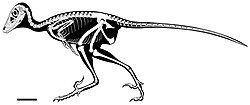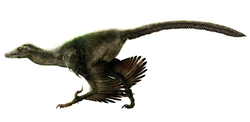| Daurlong Temporal range: Early Cretaceous (Aptian), ~ | |
|---|---|
 | |
| Skeletal reconstruction of Daurlong | |
| Scientific classification | |
| Domain: | Eukaryota |
| Kingdom: | Animalia |
| Phylum: | Chordata |
| Clade: | Dinosauria |
| Clade: | Saurischia |
| Clade: | Theropoda |
| Family: | † Dromaeosauridae |
| Genus: | † Daurlong Wang et al., 2022 |
| Species: | †D. wangi |
| Binomial name | |
| †Daurlong wangi Wang et al., 2022 | |
Daurlong (meaning "Daur dragon") is an extinct genus of dromaeosaurid dinosaur from the Early Cretaceous (Aptian) Longjiang Formation of China. The genus contains a single species, D. wangi, known from a nearly complete skeleton. Daurlong represents the first described occurrence of a preserved intestinal region in a theropod closely related to birds. [1]






